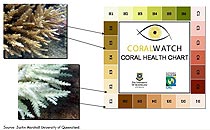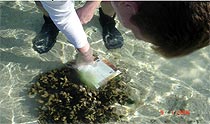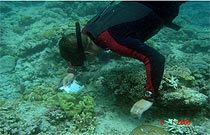| Not as deep this time I then became aware of a Coral Health Chart that was being developed by The University of Queensland, Vision, Touch and Hearing Research Centre, School of Biomedical Sciences. The colour charts are based on the actual colours of bleached and healthy corals. Each colour square corresponds to the concentration of zooxanthellae contained in the coral tissue. The concentration of zooxanthellae is directly linked to the health of the coral. The more zooxanthellae present the browner and healthier the coral. If the coral over heats, due to warmer waters or brighter and hotter UV rays, then it will expel the zooxanthellae thus making the coral lighter.
| In the field, all you need to do is match the colour of the coral with one of the colours on the Coral Health Chart. You then record the lightest and darkest colour score for each coral on to a data sheet. The lightest and darkest colour is recorded to allow for the natural colour variation within a coral. Often the coral is darkest on the underside of the coral and the lightest is on the top facing the sun. Bleached coral or coral that has been eaten will be uniform ally pale. The averaged value is used during the spreadsheet and website analyses and this is calculated within the program. |

Click for larger image |
| |
|
| Classifying corals at the species level is very difficult, so life forms are often used when recording data about coral cover or general coral health. For this purpose, the basic life forms of coral colonies can be described in a simplified manner by shape.
The Coral Health Chart uses life forms to classify corals. Branching refers to any branching coral such as some Acroporidae and Poritidae species. Boulder refers to any massive or rock shaped corals such as some Faviidae and Caryophylliidae species.
Plate refers to any coral that forms a plate like formation such as tabular Acroporidae and Agariciidae species, and the Soft category refers to corals lacking a hard skeleton, such as the family Alcyoniidae and Nephtheidae species.
|
|
| |
|
|

Figure 4: Using coral health chart
during reef walk at conference on
Heron Island research station |
Due to the dynamic nature of coral structure and form, these categories are not strict and there are many forms that do not fit into these categories. The aim is to keep the chart and survey as simple as possible, so if you’re experiencing difficulties when classifying your corals, please simply choose the closest life form.
A copy of this data sheet is included at the back of this report. |

Figure 5: Using coral reef health chart
on snorkel during conference at
Heron Island research station |
|